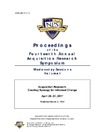Certain improvements of Newton’s method with fourth-order convergence
Abstract
In this paper we present two new schemes, one is third-order and the other is fourth-order.
These are improvements of second-order methods for solving nonlinear equations and are
based on the method of undetermined coefficients. We show that the fourth-order method
is more efficient than the fifth-order method due to Kou et al. [J. Kou, Y. Li, X. Wang, Some
modifications of Newton’s method with fifth-order covergence, J. Comput. Appl. Math., 209
(2007) 146–152]. Numerical examples are given to support that the methods thus obtained
can compete with other iterative methods.
Description
The article of record as published may be located at http://dx.doi.org/10.1016/j.amc.2009.06.007
Rights
This publication is a work of the U.S. Government as defined in Title 17, United States Code, Section 101. Copyright protection is not available for this work in the United States.Collections
Related items
Showing items related by title, author, creator and subject.
-
Active Control of Adaptive Optics System in a Large Segmented Mirror Telescope
Nagashima, M.; Agrawal, B.N. (2012);For a large Adaptive Optics (AO) system such as a large Segmented Mirror Telescope (SMT), it is often difficult, although not impossible, to directly apply common Multi-Input Multi-Output (MIMO) controller design methods ... -
A Method to Choose Between Automation and Human Operators for Recovery Actions During a Cyber Attack for Recovery Actions During a CyberAttack
Van Bossuyt, Douglas L. (Elsevier, 2019);As complex systems such as nuclear power plants, naval ships, critical infrastructure, and other systems become more connected system increases. In many systems, recovery actions can prevent an incipient failure from causing ... -
Analyzing the Effects of Source Selection Method, Acquisition Type, and Service Component on Acquisition Outcomes
Landale, Karen A. F.; Rendon, Rene G. (Monterey, California. Naval Postgraduate School, 2017-03); SYM-AM-17-043For years, one of the most hotly contested debates in contracting and acquisition has been the choice of source selection method and the contract-related consequences of that choice. While policy memos encourage contracting ...



 inc_neta_Certain_Improvements_2009.pdf (142.0Kb)
inc_neta_Certain_Improvements_2009.pdf (142.0Kb)

